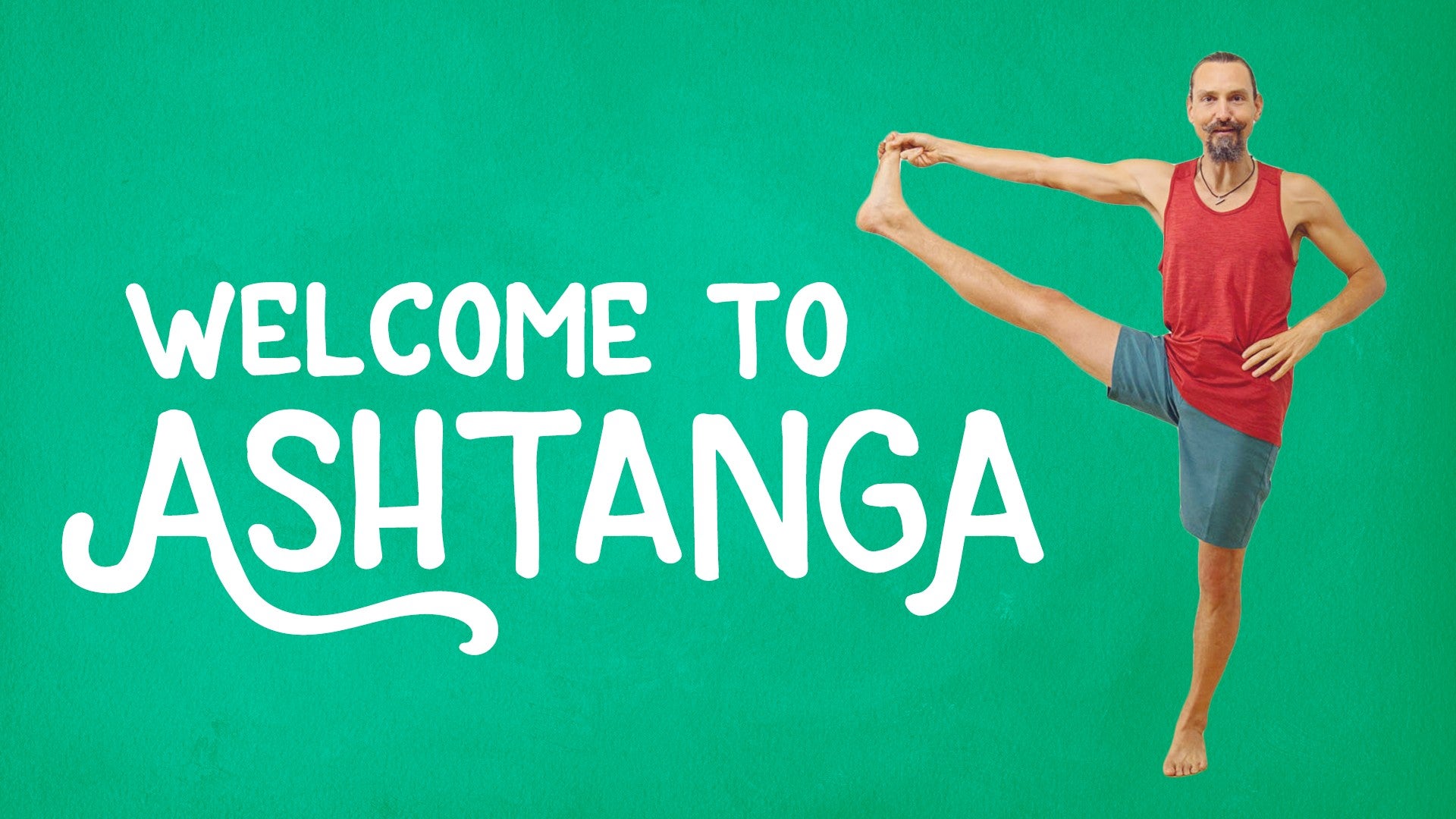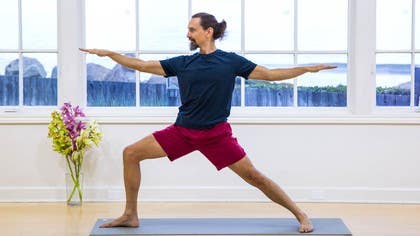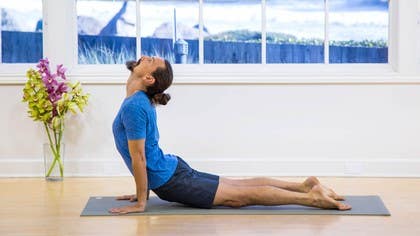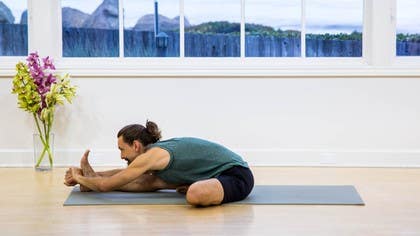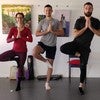Description
About This Video
Transcript
Read Full Transcript
Welcome back. As your practice deepens and develops, the openness in the hips will become increasingly cherished. So today we'll look at some ways and techniques to give you more movement and more freedom and more comfort in your hips and your pelvis, the very center of your body. Join me in Samastitihi. We'll do a few sun salutations together. Exhale completely. Surinamaskara A, Ekam, Inhale. Floating the arms upwards, see the thumbs meet together. Dway, Exhale. Folding forward, dropping the head using any modifications that you need at any time. Turini, Inhale. Lengthening the spine, looking forward. Chaturwadi, Exhale. Grounding the palms, stepping or jumping back and finding any Chaturanga variation. Pancha, Inhale. Chest forward, shoulders rolling back to upward dog or any variation. And shot exhaling into downward facing dog. Long, smooth, full deep breathing with sound. And don't be afraid to bend your knees here at first. If it helps you to get a long spine and feel like the spine is in line with the arms. Spreading through the fingers, spreading through the toes. Take one more full deep breath. Exhale completely. Five. And sapta, Inhale. Stepping or jumping the feet forward together. The head lifts, long spine. Ashta, Exhale. Folding forward, dropping the head. And nava, Inhale. Rising all the way up. See your thumbs meet together. Exhale. Samastitihi. Ekam, Inhale. Noticing that the pelvis stays neutral, the tailbone down. Dway, Exhale. Folding forward, allowing the legs to remain strong, if possible, lifting the kneecaps. Turini, Inhale. A long spine reaching the pelvis towards the back of the mat. And Chaturwadi, Exhale. Stepping or jumping the Chaturanga, trying to feel that your tailbone still points towards your heels. Pancha, Inhale. The chest forward through the broad collarbones, upward facing dog. Shat, Exhale. Downward facing dog. Lifting the hips to the back corner of the room. One. And again, it may be that your knees are bent or it may be that you're taking straight legs here. That's fine. Two. Don't be in any rush to get your heels on the mat. It can be helpful to have the heels floating for now. Three. So that you feel more length through the spine, more length through the hamstrings, more length in the breath. Take another full deep breath. Exhale completely. And Sapta, Inhale. Step or jump the feet forward. Look forward with the head up. Ashta, Exhale. And fold. And another inhale rising all the way up. Exhale, Samastitihi. Put the belly strong. Last one. Ekam, Inhale. See your thumbs. Dway, Exhale. Hear your breath guiding you through the practices. Trini, Inhale. Head up. Chaturwadi, Exhale. Any Chaturanga variation. Pancha, Inhale.
Upward facing dog. Chaturwadi, Exhale. Downward facing dog. One. Let your eyes focus on Adrishti as you gain the ability to allow awareness, to dive more deeply and deeply internal. Mula Bandha lifting the pelvic floor. Three. Udiyana Bandha scooping the belly. Four. And exhale completely. Five. Sapta, Inhale. Stepping or jumping. Feet forward with the head up. Ashta, Exhale. And fold forward. Drop the head. Nava, Inhale. Rising all the way up. See your thumbs meet. Exhale, Samastitihi. Surya Namaskara B. Ekam, Inhale. Aware of where the pelvis is. Dropping the tailbone down to point even towards the heels. Lifting the arms. See the thumbs meet. And Dway, Exhale. Keeping the knees bent. Bring the chest and torso forward so that the torso touches the thighs. Dropping the hands and then straighten in the legs as much as is comfortable. Trini, Inhale. Head up, long spine. Look forward. Chaturwadi, Exhale. Step or jump. Lower down to any Chaturanga-like position. Pancha, Inhale. Upward facing dog. Shat, Exhale. Downward facing dog. And we'll take an extra breath or two along the way here. Sapta, Inhale. Pivot on your left root knuckle. The big toe mound. Plant the left heel. Keep breathing with your next inhalation. Draw the right foot forward. Heels in a line. Planting the foot as far forward as you can comfortably. Take an extra exhale here. Bending the right knee deeply. Allow the torso to touch the right thigh. And then, Sapta, Inhale. Raising the arms. Raising the torso up. Take an extra breath here. Exhale. Bending the right knee. And feeling some opening through the left hip flexor. So the front side of the left hip may be opening as you sit down deeply in the posture. Take another breath. And then exhale. Again, put the torso towards the thigh.
Maybe touching the hands down. The right foot back. And find Chaturanga at the end of your exhalation. Now by Inhale, upward facing dog. Dasha, Exhale. Downward facing dog. Ekadasha, Inhale. Pivot and step onto the right heel. The left foot forward. Exhale here. Torso and thigh touch. Still, Inhaling. Bending the knee. Drawing the arms up. And with the exhale, bend the knee and feel the front side of the right hip. The right hip flexor opening. And then Dwadasa. Exhale. Bring the hands down. The left foot back. To any Chaturanga variation. Trayugdasha, Inhale. Upward facing. Chaturgdasha, Exhale. Downward facing dog. Allow the Drishti to stabilize and feel this practice from the inside out. So by having taken a few extra breaths along the way in Surya Namaskar B, hopefully you've gained some feelings, some sensations, some awareness of what's going on in the hips. Try to use that here in Downward Dog as every exhalation finds Uddiyana Bandha but you're also aware of the feeling and sensation in the hips at the moment. Exhale completely. And Pancharasha. Inhale. Step or jump the feet forward. The head up. Look forward. Chodhasha. Exhale. And forward. Perhaps still aware of how it feels in the hips to do forward folding. Saptarasha.
Inhale. Bend the knees. The chest and thighs are touching. And then rise the spine away from the floor. Looking at the thumbs. Exhale. Samastitihi. We'll do one more at a decent pace. Aikum. Inhale. Bend the knees. Pelvis drops. Arms up. Dway. Exhale. Folding forward. Chest on the thighs. Then the legs come straight. Trini. Inhale. Head up. Look forward. Chaturadi. Exhale. Step or jump. Chaturanga. Pancha. Inhale. Upward facing. Shadda. Exhale. Downward facing dog. Sapta. Inhale. Drawing the right foot really far forward with the knee deeply bent feeling into the front of the left hip as you rise. And ashta. Exhale. Hands down. Chaturanga dandasana. Nava. Inhale. Upward facing. Dasha. Exhale. Downward facing dog. Ekadasha. Inhale. The left foot forward. Feeling the front side of the right hip aware of where the pelvis is. Dwadasha. Exhale. To any Chaturanga variation. Trayugdasha. Inhale. Upward facing.
Chaturgdasha. Exhale. Downward facing dog. Letting the head dangle and hang and returning awareness to your very center. Moolabhandha. Rudyanabhandha. And breath. Exhale completely. Pancharasha. Inhale. Step or jump the feet forward together. Head up. Chursha. Exhale. And fold forward. Drop the head aware of the closing distance between torso and thighs. Saptarasha. Inhale. Bend the knees. Torso and thighs in contact. Then raising the arms as the head and spine raise up towards the lifted arms. Exhale. Samastitihi. Into the standing postures. Inhale. Jump your feet or step your feet a hips distance apart. Exhale. Fold forward and grab the big toes. Padangusthasana. If you can't grab the big toes you can simply take the ankles or shins somewhere. But for all of us today let's bend the knees and see if we can again draw the torso closer to the thighs here. So it's less of a hamstring stretch for us and more of trying to find some opening in the hips. Again inhale a long spine and exhale folding forward. See if you can rest the torso on the thighs and breathe here as you drop the head. Trying to find some sensation, some feeling in the hips.
For so many of us practicing our stranga the hamstrings and the lengthening the backs of the entire leg become the first part of our practice. But soon we have to move on to some kind of opening in the hips. So if hamstrings have felt like a limitation for you don't worry. Hip opening is still available to you and we'll find some ways today to bend the knees and allow the hamstrings to not hold you back from hip opening. Exhale completely. Tereenie. Inhale. Head up. And exhale here. Inhale. Come all the way back up. And then exhale step or jump your feet back together in samastitihi. Trikonasana A. Ekame now take your right foot and step a medium step towards the back of the room. The right toes face towards the back of the room. And then Dwe exhale reaching your right arm out over the right thigh. Take your time breathing freely as you descend and you can use your left hand to try to cue the left hip back. To grab the big toe you might feel like the left hip has to dive in forward towards the mat. That's okay for now whether you're taking a toe or letting the hand hang. Then put the left hand on the hip for this practice and with an inhalation try to draw the left shoulder back. Draw the left hip back and try to open the entire torso out over the right thigh from the pelvis up through the crown of the head looking up towards the ceiling and breathing. Still with strong legs if you want to install the upper arm for the last breath or two great. But try to keep the awareness in the hips. Exhale completely. You can bend the knee and train the inhale come up. Pivot on the feet to change the side. Again the limitation of the hamstring might be frustrating. It might feel like you can't get down so far in these postures. And again don't worry because there'll be plenty of bent knee postures that will allow you hip opening in this practice and for many moons to come. Exhale and go forward and use the right hand to open the hip. See if you can find a sensation even through the outside of the torso, the lateral side of the torso and deep into the hip itself. And install the upper arm if you like for the last few breaths. To exit, inhale bend the knee and come up. Then exhale back to samastitihi at the top of the mat. Parshvakonasana A, Ekam Inhale, take your right foot and step a long step towards the back of the room. Pivot on your right heel so that your right toes face towards the back. And now here we go with the bent knee and the hamstring taken out of the equation will come through Virabhadrasana B. So bend your right knee deeply, exhaling to get the knee above the ankle and you could place the hands up, take a breath with the arms lifted and then cheat the hands in to see that again the hips are opening. So left hand can take the left hip away from the right knee. The right hand can make sure that the right knee stays above the right ankle and there's a bit of opening through there. Wear that opening can be reflected is through the external rotation of both thighs so you can use your hands to try to feel like you're peeling open both thighs and you should be able to feel this deep in the pelvis somewhere in left hip or in right hip or in both and keeping that feeling in the sensation in the hips then put the arms back up. Take a breath or two here making sure the tailbone still dives down towards the mat and then exhaling keeping the right knee bent you can put the right forearm on the knee or the right hand down outside the foot and use the left arm to again peel back the hip external rotation of both thighs and you could install the upper arm but keep the sensation in the low belly in the hips themselves. Exhale completely and trainee inhale come up pivot on the heels and chatwadi exhale let's go through Virabhadrasnabhi again exhale bending the left knee seeing that this right hip may want to dive forward and point towards the front and then using the left hand to pull the right hip back noticing as the left knee wants to sneak in using the left hand to create openness so there's openness between the right hip and left knee and the hands accentuate that and then confine the external rotation of both thighs as you roll open tailbone down belly strong and then the arms come up and exhale keeping the lower body as it is perhaps the left forearm on the left knee the right arm still lifting forward or using the right hand draw the hips more open maybe even taking the full expression of the posture with the left hand outside the left foot and then installing the upper arm and breathing but keeping your awareness in the very center of the body punch your inhale come up feet parallel arms out and exhale samastitiy and now heading off to seated postures through Vinyasa Ekam inhale rise the chest open the collarbones the arms spread upwards to exhale fold forward drop the head down trainee inhale head up long spine look forward and Chaturwadi exhale step or jump lower down when he chaturanga punch inhale upward facing dog shot exhale downward facing dog and Sapta come to a sitting position inhaling as you hop or step the feet forward and then straighten the legs out in front of you in dandasana your neutral seated posture now we'll look at baddha konasana so bending both knees will completely eliminate any limitation of the hamstrings but the other concern is that then we have to make sure that the knee feels great that it feels very comfortable that there's no pinching or pulling especially on the inside of the knee so the baddha konasana will approach it twice today the first baddha konasana practice will simply be drawing the feet together and holding the feet and trying to lift the chest as best we can through the shoulders wrapped back and down and be here with a long breath and a long spine no bouncing of the knees just let gravity gently work you can use the hands to slightly open the feet up like a book but again if there's any pinching in the knee draw yourself into a less extreme posture even drawing the knees further away from the pelvis and breathe and breathe and breathe so it may be that here simply by relaxing into the posture you feel more and more sensation warmth deep in the hips and then comfortably and gently the hips start to open and allow the feet to shine up towards the sky opening the feet like a book and keeping the spine long and the breath long as well now we'll draw to navasana you can keep the hands right onto the knees give a little resistance as you squeeze the knees towards one another moving through the hands and then the knees squeezed together that should relieve any discomfort deep into the hip and then straighten the legs as best you're able and take a few breaths here inhaling draw the legs straight into dandasana your neutral pose of seated and let's look at upavishta konasana so here we'll spread the feet wide apart from one another the knees will stay straight so there's no issue with pinching of the knee you don't have to worry about but again the hamstring might feel like a limitation let's see what happens for you inhale reaching forward you might take the shin or the ankle or even the outside of the foot and again try to find the lengthening of the spine still breathing if you're able to take the outside of the feet great roll the shoulders back and down let the chest come forward if you start to feel that the hamstrings are big limitation in this feel free today to bend the knees and again let the torso come very close or even in contact with the thighs so that the spine is long and you're breathing deeply it's not the traditional posture but hopefully you can find some hip opening as the torso wants to move even past the thighs and again looking for sensation in the hip whatever variation you find yourself in now inhale draw the spine long and come up exhale here and then cross the legs plant the hands and we'll take vinyasa inhale to lift up off the mat exhale to find your way to chaturanga dandasana inhale to upward facing dog exhale to downward facing dog and let's look at a variation of ekapada rajkapatasana or conventionally known often as a pigeon posture inhaling draw the right foot behind the left wrist and the right knee behind the right wrist and then allow the left foot to slide back and away as the hips gently lower down to the mat always keeping track of the sensation in the knee make sure it feels fine let's have you dorsey flex that right foot that is draw the right toes towards the very center of the body the center of the mat and spread the toes deeply to help protect the knee if it's very challenging for you the right heel might be very close to the pelvis and you can keep the arms to rest upon and stay lifted and long if it's quite easy for you you can bring the heel very far away from the pelvis or even in front of the body and then you should be able to feel some deep stretch in the underside of the right hip again inhale lengthen the spine and take your time with it slowly exhaling a little bit of the way forward and inhale lengthen the spine keeping the right foot dorsey flex whatever position you're in keeping the toes spread and at the same time internally rolling your left thigh so the left hip doesn't bounce or float away from the mat it tries to stay moving towards the mat just in line the same height as the right hip you can come forward as deeply as you like or stay as lifted as you like as long as you breathe and find sensation in the hips the left toes can be pointed straight back behind you or they can be tucked under it's up to you everything relaxes and lets go except for your awareness in the right foot dorsey flex toes spread and the left thigh internally rolling to keep the hips level aside from that you focus on your breath and let the deep hip opening occur no need for pushing or bouncing just letting go take one more full deep breath here exhale completely with your next inhale walk the hands back lift the chest exhale and take your time inhaling your way to a long spine position inhaling your way so the hands come pretty close to where they were at the beginning of this practice exhale completely with your next inhale tuck your left toes under see if you can lift the right foot and right leg up off the mat and exhale step it back to chaturanga or any variation there inhale upward facing dog exhale downward facing dog left side inhaling the left foot behind the right wrist and the left knee behind the left wrist letting the right foot slide behind you and setting the difficulty level by bringing the foot further out or closer in dorsey flex the left foot spread the toes and internally rotate the right thigh inhaling length and exhaling forward you'll probably notice one hip will be more open than the other and that's wonderful that you've noticed it's very unlikely that both hips have the same amount of freedom movement and flexibility what really matters more than you trying to equalize them or push them is just that you're aware which hip is more open at this moment on this day so you can modify as needed and take good care if there's any sensation in the left knee take a less extreme posture until you feel the knee is completely empty and free of sensation internally rolling the right thigh keeping the left toes active and aware and the foot dorsey flexed and breathe letting everything else relax release and the hip open one more full deep breath here and then inhaling walking the hands back exhaling to ground inhaling a long spine walking the hands back and exhale grounding inhale chest open the hands come back just in front of the left shin exhale here with your inhale tuck your toe under lift the left leg up off the mat exhale step it back to chaturanga dandasana inhaling upward facing dog quite likely feeling that through the hips as they've opened things have changed you feel more sensation exhale to downward facing dog agni stambasana inhale come through straight legs sit down in dandasana i'll turn towards you so that you can see how we stack the knees in agni stambasana let's start with the left leg put your left leg so the shin is parallel to the front edge of the mat see how that feels if the knees close to the mat like mine great if it feels like it's very tight in the hip and the knee is quite lifted you can simply cross the legs for any of these positions if you're comfortable with the foot dorsey flex just as it was in the previous pigeon variation see about placing the right ankle onto the left knee not in a lotus position but so that both shins are parallel to the front edge of your mat from here you'll get a bit of a test about how open the right hip is and how much external rotation can happen through the right thigh if the right knee is pretty close to the left ankle you may be able to inhale lengthen the spine and exhale gently move forward if you feel that this is already painful or if there's pinching in the knee simply cross the legs and you can exhale and go forward in any crossed legged position taking some breaths there with time this right knee may be able to touch the left ankle the feet are dorsey flex so the toes are pulled towards the center the midline and again you can use the hands to support the forward movement or you could use the hands to even assist as you fold forward in agni stambasana the fire sticks pose and then take a few breaths coming out release the legs anytime the knee may have been compromised I like to straighten the legs in space you can take navasana and then take dandasana inhaling and exhale open the right shin under this time parallel to the front edge of the mat and test and see what's happening with the sides the left ankle right onto the right knee feet are dorsey flex pulled towards the center this side might be more open or more tight it's fine as long as we notice it you can simply breathe here or you can fold forward and of course you're always welcome to do the posture with crossed legs folding forward and breathing inhaling taking a few breaths to draw yourself back up to the seated posture and then from here we'll re-approach vadakonasana straighten the legs first take navasana inhale to dandasana and then exhale draw the feet back together as we began our seated practice for today using the thumbs just under the pad of the toes and the fingers on the top of the feet see if you can keep the elbows close to the torso and inhale open the feet like a book draw the center of the chest up through the shoulders rolling back and down and breathe here pinching in the knee less extreme variation if you can't get rid of any tension in the knee you may want to put a block or a pillow under the knee and you're welcome to stay here breathing deeply in a long spine position or if comfortable start to feel what it's like to draw the spine and torso forward so that the pelvis rolls over the femurs and the hips are opening as you gently go forward you can use gravity to assist you or if you like you can use the pulling on the feet feel like you're pulling your feet up towards your chest and maybe that will draw your chest forward towards your feet as you breathe inhale long spine exhale you may find a little more depth and go forward and inhale rising back up to the straight up and down position take an extra breath here exhaling inhaling the chest open the collarbones broad and exhale keeping the feet and the hips in that position will exhale and lie down on our backs for Supta Baddha Konasthma you can use your hands to support the downward journey and see if that creates even more sensation even more wonderful opening in the hips as you simply find a way to take rest and release and relax and let gravity open the hips by gently drawing the thighs and knees towards the mat no need for bouncing no need for pushing or pulling just breathe if it's super intense on the hip or the knee of course you could prop under the knees but if you're able to let them comfortably be opened by gravity all you have to do here is completely let go no limitation of the hamstring or the balance just a completely relaxed hip opener take a few more breaths here appreciating the openness coming into the hips and then again place the hands gently towards the knees and gently draw the knees through slight resistance of the hands so that the knees squeeze one another and then draw the knees in towards the chest you can do a little squeezing and even a little rolling side to side and then release all the limbs out and take rest let the palms roll open to the sky let the feet roll out to the side and breathe so much of our practice is reliant on keeping things in place or trying to do this or that it's really important to remember how relaxing and releasing are an equally important part of all these yogic practices just let go and breathe you could even release udiyana bandha on the physical level letting breath flood the lower abdomen so you have access to a really relaxing breath completely letting go see if you can reach awareness deep into the pelvis deep into the hips and just let go release the jaw release the eyebrow release the eyes and let go release the abdomen release deep into the hips and let go then returning a little faint smile into the relaxed lips you can gently bring some motion back through the arms and legs however you like perhaps aware of that newfound sensation and newfound growing freedom in the hips you could bend the knees and roll over onto one side take a few breaths there and then gently bring yourself back up to any comfortable seated position and see if there is comfort in your seated posture the value of sitting practices can be transcendent so opening hips is not only valuable for dynamic practices but also for the ancient and beneficial stillness practices that involve maintaining a comfortable seat so you're welcome to stay here and do any kind of practices that involve you sitting breathing and finding stillness thanks for your kind attention keep practicing blessings on your path
Welcome to Ashtanga
Comments
You need to be a subscriber to post a comment.
Please Log In or Create an Account to start your free trial.
